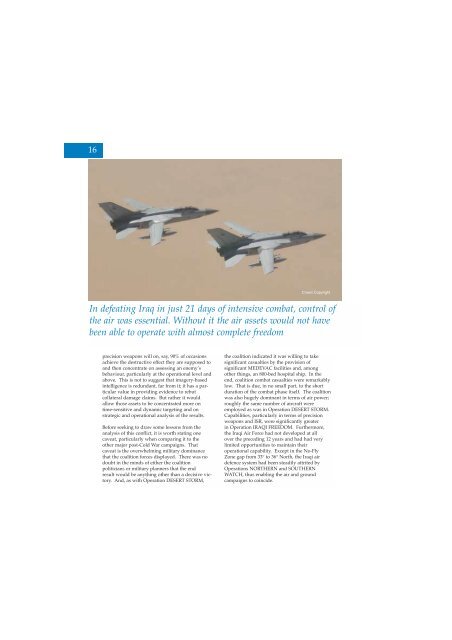Volume 6 No 4 - Royal Air Force Centre for Air Power Studies
Volume 6 No 4 - Royal Air Force Centre for Air Power Studies
Volume 6 No 4 - Royal Air Force Centre for Air Power Studies
Create successful ePaper yourself
Turn your PDF publications into a flip-book with our unique Google optimized e-Paper software.
16<br />
Crown Copyright<br />
In defeating Iraq in just 21 days of intensive combat, control of<br />
the air was essential. Without it the air assets would not have<br />
been able to operate with almost complete freedom<br />
precision weapons will on, say, 90% of occasions<br />
achieve the destructive effect they are supposed to<br />
and then concentrate on assessing an enemy’s<br />
behaviour, particularly at the operational level and<br />
above. This is not to suggest that imagery-based<br />
intelligence is redundant, far from it; it has a particular<br />
value in providing evidence to rebut<br />
collateral damage claims. But rather it would<br />
allow those assets to be concentrated more on<br />
time-sensitive and dynamic targeting and on<br />
strategic and operational analysis of the results.<br />
Be<strong>for</strong>e seeking to draw some lessons from the<br />
analysis of this conflict, it is worth stating one<br />
caveat, particularly when comparing it to the<br />
other major post-Cold War campaigns. That<br />
caveat is the overwhelming military dominance<br />
that the coalition <strong>for</strong>ces displayed. There was no<br />
doubt in the minds of either the coalition<br />
politicians or military planners that the end<br />
result would be anything other than a decisive victory.<br />
And, as with Operation DESERT STORM,<br />
the coalition indicated it was willing to take<br />
significant casualties by the provision of<br />
significant MEDEVAC facilities and, among<br />
other things, an 800-bed hospital ship. In the<br />
end, coalition combat casualties were remarkably<br />
low. That is due, in no small part, to the short<br />
duration of the combat phase itself. The coalition<br />
was also hugely dominant in terms of air power;<br />
roughly the same number of aircraft were<br />
employed as was in Operation DESERT STORM.<br />
Capabilities, particularly in terms of precision<br />
weapons and ISR, were significantly greater<br />
in Operation IRAQI FREEDOM. Furthermore,<br />
the Iraqi <strong>Air</strong> <strong>Force</strong> had not developed at all<br />
over the preceding 12 years and had had very<br />
limited opportunities to maintain their<br />
operational capability. Except in the <strong>No</strong>-Fly<br />
Zone gap from 33° to 36° <strong>No</strong>rth, the Iraqi air<br />
defence system had been steadily attrited by<br />
Operations NORTHERN and SOUTHERN<br />
WATCH, thus enabling the air and ground<br />
campaigns to coincide.
















